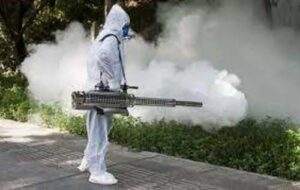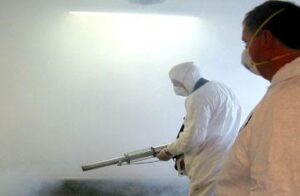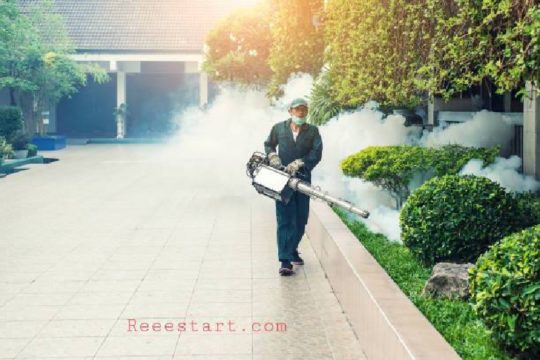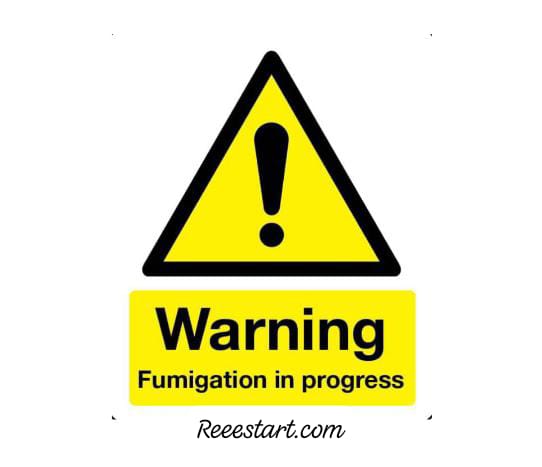Thermal fogging is a pivotal term frequently encountered in the field of pest control. This concept involves the production of ultra-fine droplets, which typically range in size from 1 to 50 micrometers, through the utilization of thermal energy. During this process, liquid substances are vaporized at the end of the fogging barrel, subsequently forming an extremely fine mist. This mist is created via condensation when the vaporized particles come into contact with the cooler ambient air upon release. The end result is dense, visible fog clouds. It’s important to note that pure oil solutions or aqueous fluids containing glycol components are particularly effective for this purpose, as they optimize the fogging process and ensure the efficient dispersion of the fog.
Uses of Thermal Fogging in Pest Control
Thermal fogging has a broad spectrum of applications, making it an invaluable tool in pest control and related fields:
- One of the primary uses is in the control of disease vectors, such as mosquitoes, which are notorious for spreading diseases like malaria, dengue fever, and Zika virus.
- By generating a dense fog that can penetrate even the most inaccessible areas, thermal fogging effectively targets and eliminates these vectors, thereby reducing the risk of disease transmission.
- In addition to vector control, thermal fogging is extensively used for disinfection purposes. In environments that require stringent hygiene standards, such as hospitals, laboratories, and food processing plants, thermal fogging can disinfect large areas quickly and efficiently.
- The fine mist created by this process can reach every nook and cranny, ensuring comprehensive coverage and effective eradication of pathogens.
- Another significant application of thermal fogging is in the monitoring and protection of stored products. In warehouses and storage facilities, pests like insects and rodents can cause significant damage to stored goods.
- Thermal fogging helps in controlling these pests, thereby protecting the integrity and quality of the stored products.
- Furthermore, thermal fogging plays a critical role in plant protection. It is used to apply pesticides and other protective agents to crops, ensuring that they are safeguarded against pests and diseases. The fine mist can cover large areas uniformly, providing an effective protective barrier for the plants.

Components of Thermal Fogging Devices
Understanding the intricacies of thermal fogging also involves a closer look at the components that make up the fogging devices. All thermal fog generators share certain fundamental components:
- A carburetor, a mixing tube, a combustion chamber, and a resonator. These components work together seamlessly to create the desired fogging effect.
- The carburetor’s role is to mix the fuel with air in the correct ratio to ensure efficient combustion
- . This mixture is then introduced into the mixing tube, where it is further refined and prepared for combustion.
- The combustion chamber is where the magic happens; the fuel-air mixture is ignited, creating a pulsating stream of hot gases.
- This pulsating gas stream is vital as it provides the energy needed to vaporize the liquid solution.
- The resonator, positioned at the open end of the combustion system, plays a crucial role in fog generation.
- When the solution is introduced into the hot gas stream at the resonator’s tip, it undergoes rapid vaporization and subsequent condensation, resulting in the formation of a dense fog.
- This fog is then expelled from the device, ready to perform its intended function.

Operational Efficiency of Thermal Fogging
One of the standout features of thermal fogging is its rapid action. Under suitable weather conditions, thermal fogging can produce noticeable effects in a remarkably short time. This is especially beneficial in emergency situations where immediate pest control or disinfection is required.
When used indoors, thermal fogging displays exceptional efficiency in filling spaces thoroughly, even reaching small cracks and corners that might be inaccessible through conventional methods. This comprehensive coverage is key to its effectiveness, ensuring that pests have no place to hide and that pathogens are eradicated from every possible surface.
Moreover, thermal fog generators are versatile in their application. They can be used with both oil-based and water-based solutions, providing flexibility in terms of the type of treatment required. This adaptability makes them suitable for a wide range of environments and applications.
In conclusion, thermal fogging is an essential technique in the arsenal of modern pest control and disinfection strategies. Its ability to generate ultra-fine droplets, coupled with its wide range of applications and operational efficiency, makes it a go-to method for professionals in the field. Understanding the components and functioning of thermal fogging devices, along with their diverse applications, underscores their importance in safeguarding public health and ensuring the protection of valuable goods and crops. For those dedicated to mastering the pest control industry, a deep understanding of thermal fogging is not just beneficial—it is indispensable.




